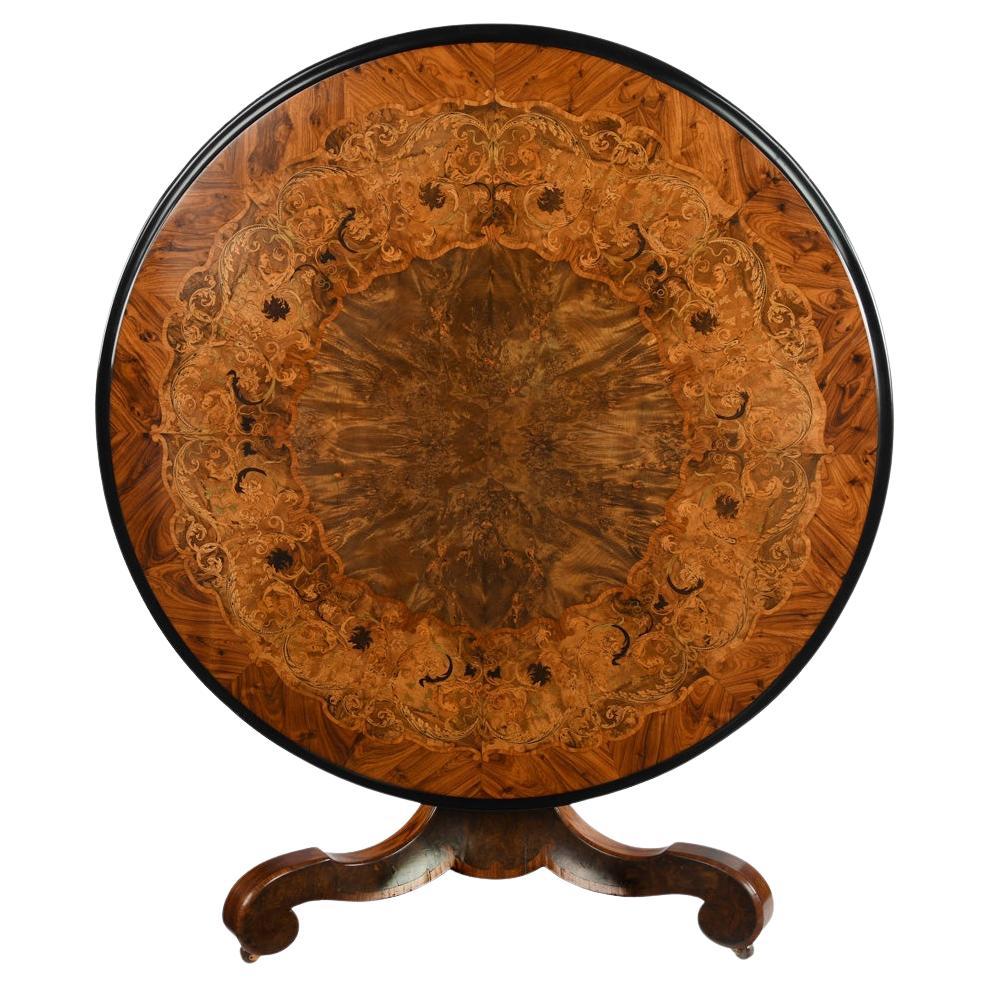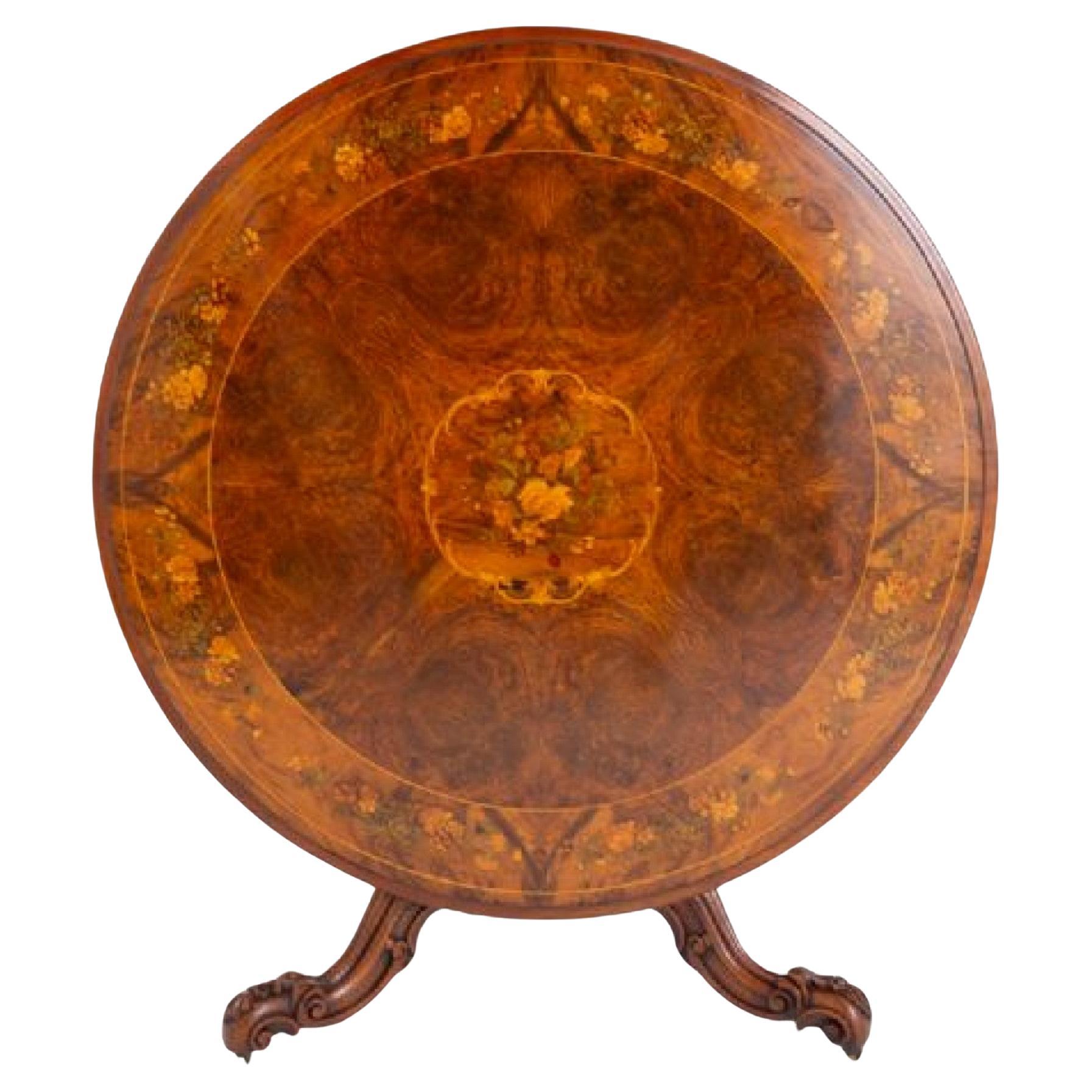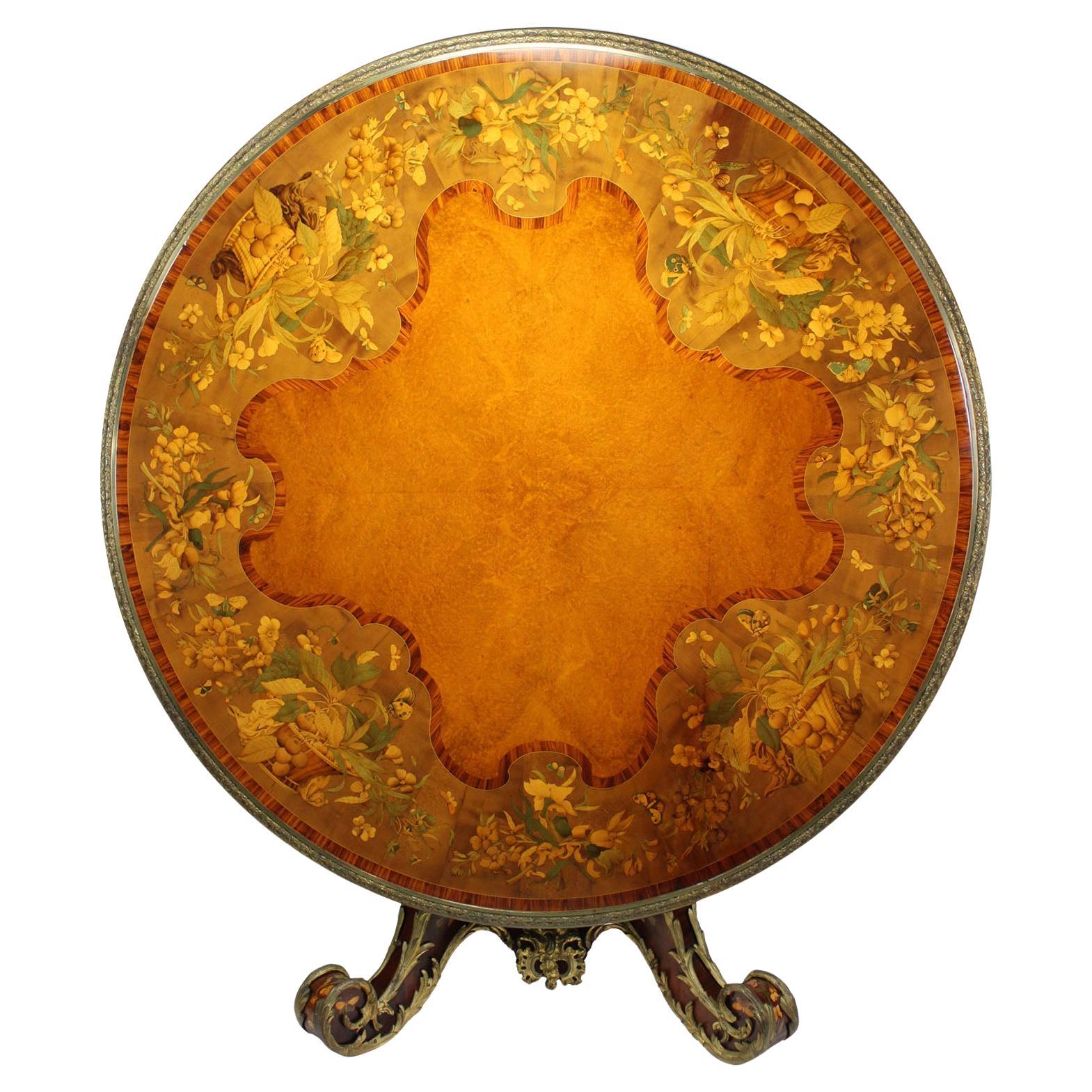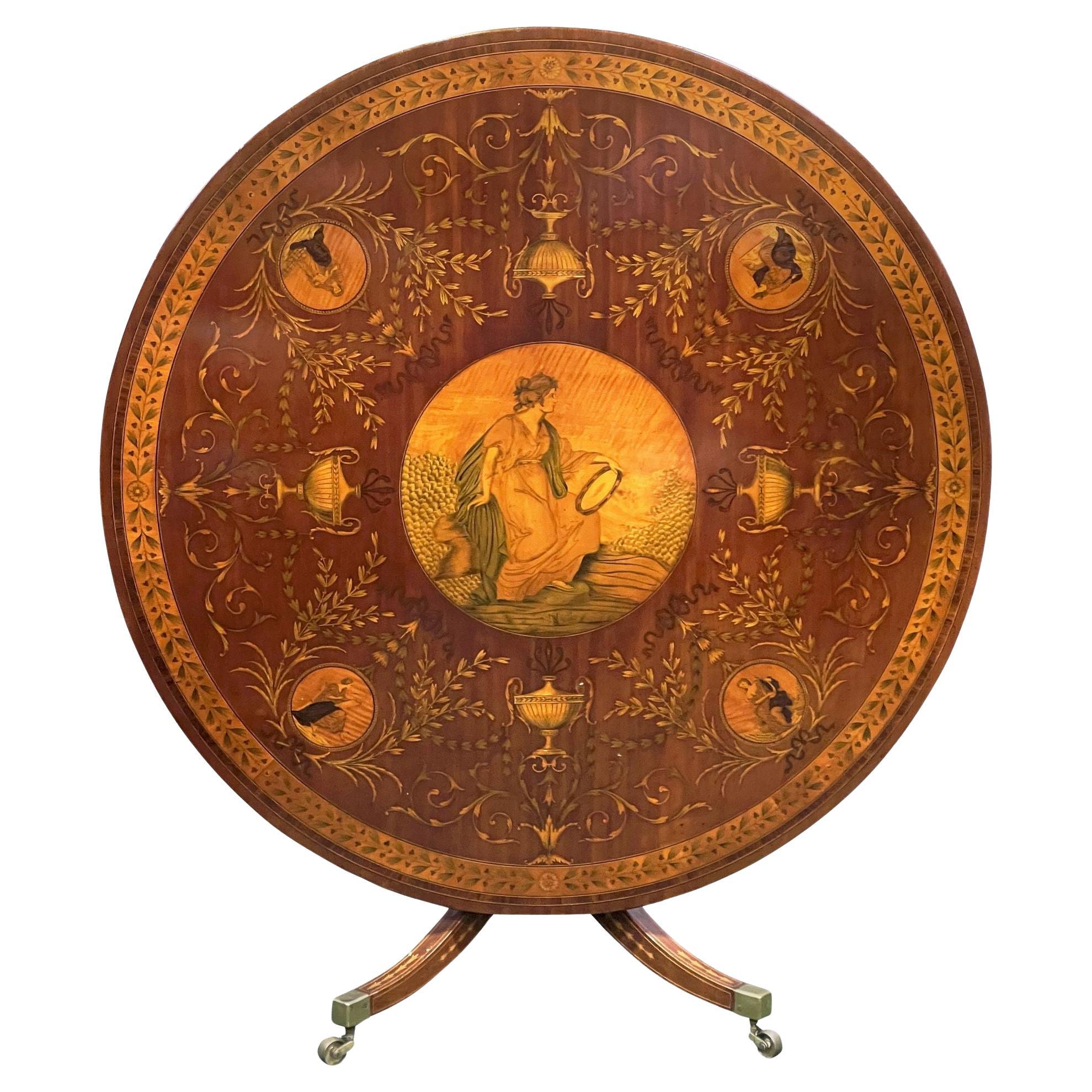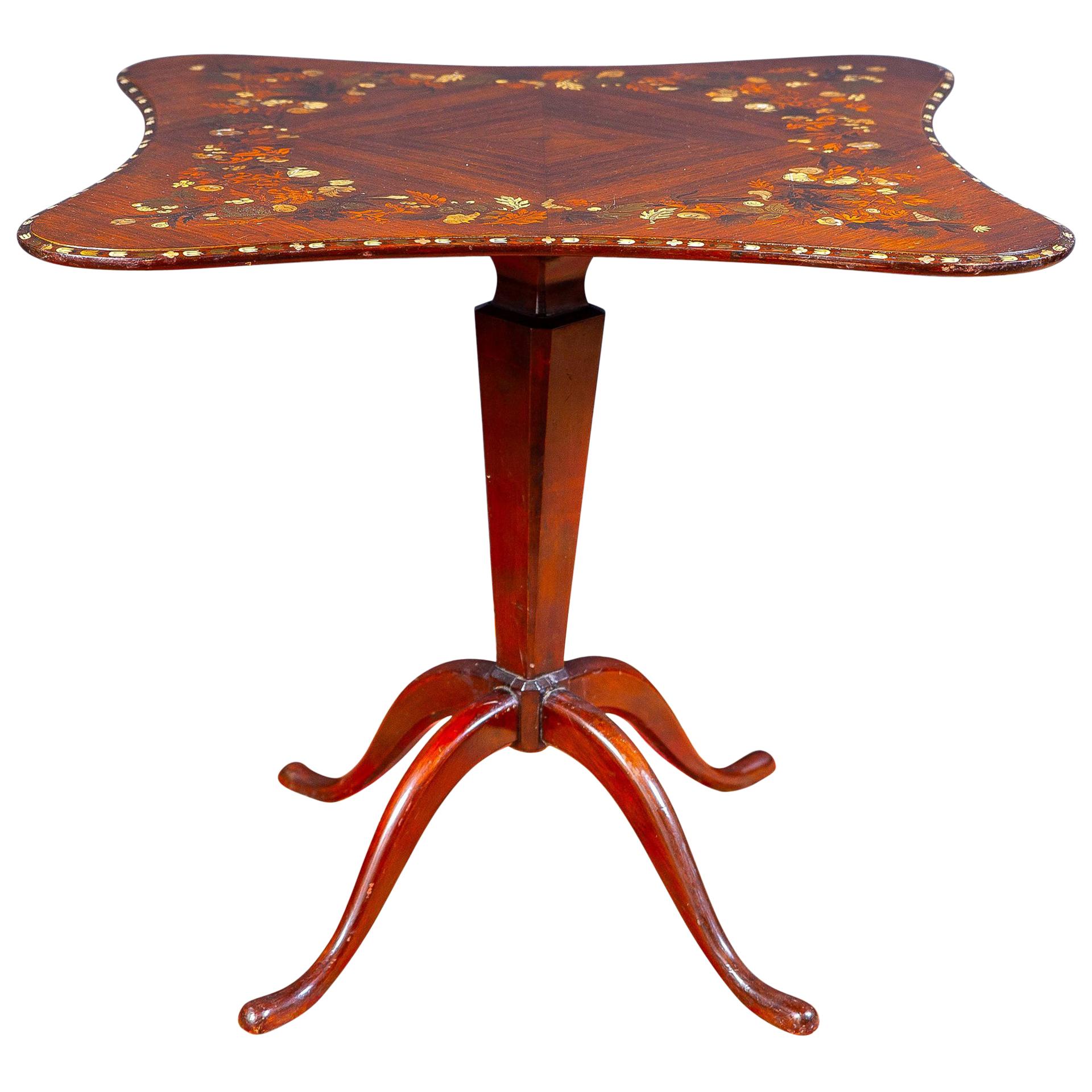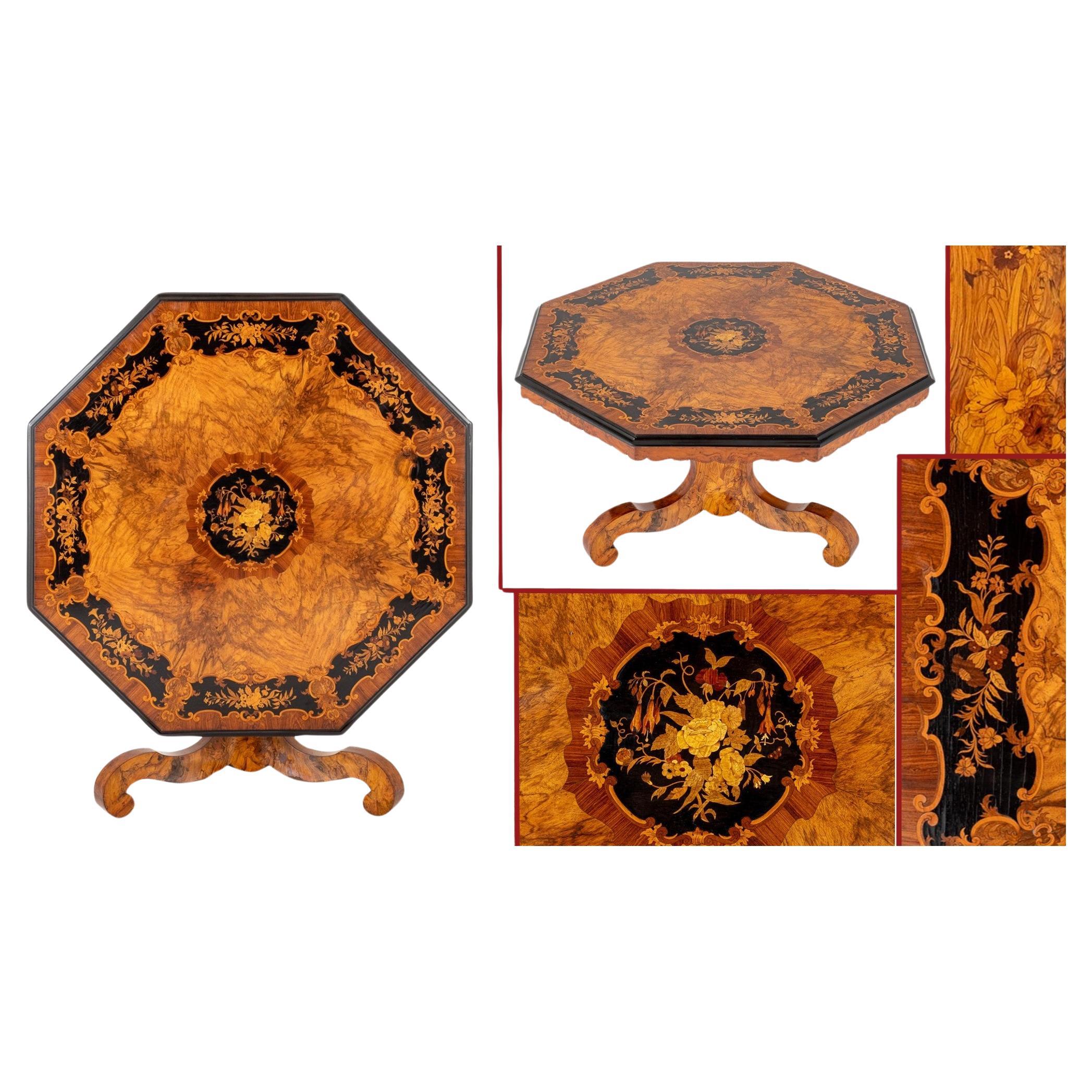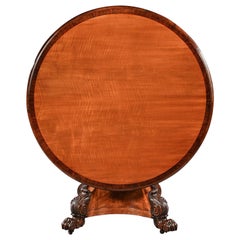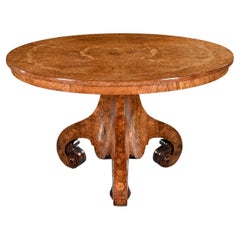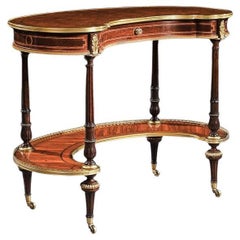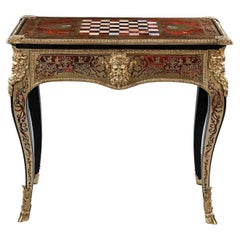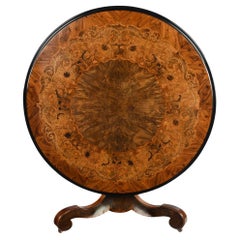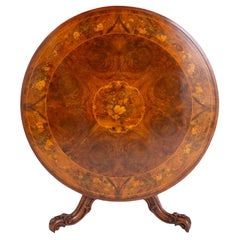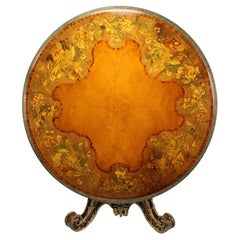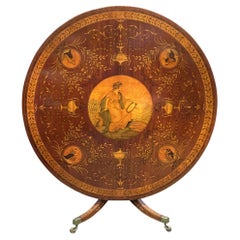Items Similar to Exceptional 19th Century Marquetry Centre Table, Edward Holmes Baldock
Want more images or videos?
Request additional images or videos from the seller
1 of 11
Exceptional 19th Century Marquetry Centre Table, Edward Holmes Baldock
$32,268.36
£23,500
€27,503.68
CA$44,516.46
A$48,935.83
CHF 25,718.43
MX$594,259.25
NOK 320,830.94
SEK 303,964.76
DKK 205,266.89
About the Item
An exceptional marquetry and ormolu centre table of exhibition quality attributed to Edward Holmes Baldock.
English, circa 1840.
Finely constructed, the burr maple circular hinged top with an ebony band enclosing a marquetry chain of flowers inlaid in specimen stained woods and mother of pearl with butterflies and caterpillars, set within a tulipwood boarder and foliate cast ormulo edge.
The table rises from inwardly scrolling tripartite feet, having concealed brass castors, with finely chased foliate ormolu mounts and rosettes, joining to a central shaped baluster stem veneered in contrasting dark burr wood and inlaid tulipwood.
Offered in excellent condition this table is an extremely rare design first inspired by Richard Bridgens as published in his 1838 book 'Furniture with Candelabra' plate 16 of a 'Marquetrie Centre Table’ with pedestal base and scrolled feet. This type of table is also associated to Edward Holmes Baldock (whom we have attributed this table to) who was a fashionable London art dealer, furniture maker and restorer of Hanway Street and probably the most distinguished dealer of his day.
Edward Holmes Baldock (1777-1845)
Born on the 14th May 1777 he established his business in 1805 in Hanway Street which over the years he expanded at this location. He soon was a prominent London furniture dealer to several members of the Royal Family and is responsible for supplying French-fashioned furniture to the 5th Duke of Buccleuch.
Edwards Holmes Baldock’s pieces have become a prized possession amongst collectors, museums (V&A included) and dealers alike. The use of a variety of specimen woods to form the butteries and caterpillars can often been seen on attributed and signed tables of Edward Holmes Baldock reminiscent to those on the present table. Baldock was thought to have worked very closely to with the master of marquetry and inlay of the 19th century Robert Blake whom had workshops adjacent to Baldock’s retail premises.
Pieces in public collections of the Blake Family include a piano in the Metropolitan Museum of Art, a writing desk in Goodwood House, a centre table in Syon House, a circular table in Alnwick Castle, an octagonal table in the Leeds City Art Gallery at Temple Newsam House and also signed works in the Victoria and Albert Museum.
His works often imitated the important pieces of 18th century French furniture that francophile collectors including George, Prince of Wales, later George IV, William Beckford, Francis Seymour-Conway, 3rd Marquess of Hertford and George Watson-Taylor collected at the beginning of the 19th century.
The inlay and marquetry on this table is most likely to have been undertaken by The Blake Family upon instructions from Baldock.
Dimensions:
Diameter 44 inches - 112cm
Height 29 1/4 inches - 75cm.
- Attributed to:Edward Holmes Baldock (Cabinetmaker)
- Dimensions:Height: 29.53 in (75 cm)Diameter: 44.1 in (112 cm)
- Style:Early Victorian (Of the Period)
- Materials and Techniques:Ebony,Maple,Tulipwood
- Place of Origin:United Kingdom
- Period:Mid-19th Century
- Date of Manufacture:1840
- Condition:Wear consistent with age and use.
- Seller Location:Benington, GB
- Reference Number:Seller: 28571stDibs: LU1183226033952
About the Seller
5.0
Gold Seller
Premium sellers maintaining a 4.3+ rating and 24-hour response times
Established in 1969
1stDibs seller since 2015
128 sales on 1stDibs
Typical response time: 5 hours
Associations
LAPADA - The Association of Arts & Antiques DealersThe British Antique Dealers' Association
- ShippingRetrieving quote...Shipping from: Benington, United Kingdom
- Return Policy
Authenticity Guarantee
In the unlikely event there’s an issue with an item’s authenticity, contact us within 1 year for a full refund. DetailsMoney-Back Guarantee
If your item is not as described, is damaged in transit, or does not arrive, contact us within 7 days for a full refund. Details24-Hour Cancellation
You have a 24-hour grace period in which to reconsider your purchase, with no questions asked.Vetted Professional Sellers
Our world-class sellers must adhere to strict standards for service and quality, maintaining the integrity of our listings.Price-Match Guarantee
If you find that a seller listed the same item for a lower price elsewhere, we’ll match it.Trusted Global Delivery
Our best-in-class carrier network provides specialized shipping options worldwide, including custom delivery.More From This Seller
View AllRare 19th Century Peters of Genoa Satinwood & Rosewood Centre Table
By Henry Thomas Peters
Located in Benington, Herts
A rare and finely constructed circular satinwood centre table most probably by Henry Thomas Peters of Genoa.
Italy Circa 1830.
The circular tilt top having a finely chosen cuts of book-matched West Indian satinwood veneer with a rosewood banded and moulded edge over a splayed in-curved quatroform base, terminating on four acanthus carved scrolled rosewood lions paw feet raised on brass castors.
A very fine table with wide cuts of satinwood which would have been extremely expensive in the early 19th Century. Inspired by the French Empire design as viewed through the lens of English Regency, in particular the designs of Thomas Hope of 1807, along with the construction all point to Henry Thomas Peters being the maker, active in Genova around 1820 to 1850, being one of the leading cabinet makers of the period obtaining the title of ‘cabinetmaker of his Majesty’.
Henry Thomas Peters’ English antecedents remain obscure although he probably began his career in England. However, he is not listed in Beard and Gilbert’s Dictionary of English Furniture Makers 1660-1840. He arrived in Genoa in circa 1817, and by 1824 had established a workshop in Via Balbi, a neighbourhood in which the Royal Palace and other noble residences were located; today some of his works are preserved in the Palazzo Rosso, Genoa and were probably bequests from the various aristocratic families for whom he worked, including the Brignole Sale family.
Peters was appointed by the Court of Savoy and produced furniture for their palaces in Turin, Genoa and Racconigi including the Palazzo Reale. Notably, in 1841, furniture for the wedding of Prince Vittorio Emanuele. In 1846, Peters and his extensive workshop won the silver medal at the Esposizione dei Prodotti e delle Manifatture Nazionali. As pointed out Peters was famed for producing furniture with the technical accuracy typical of English but adapted to the late Italian Empire style.
A set of six Italian Giltwood...
Category
Antique 19th Century Italian Center Tables
Materials
Rosewood, Satinwood
Fine Burl Amboyna and Marquetry Centre Table Attributed to George Blake and Co a
By George Blake & Co.
Located in Benington, Herts
A Fine Burl Amboyna and Marquetry Centre Table Attributed to George Blake and Co and Probably Retailed by Edward Holmes Baldock
English London made Circa 1845.
An exceptional table of wonderful colour, utilising the finest amboyna veneers as a background for a complex pattern of floral marquetry on the stem, feet and table top.
The tilt-top with segmented veneers and central floral inlay within an inlaid floral scroll surround and with a conforming inlaid outer border. The triform pedestal base with foliate inlay, carved leaf scroll feet with carved lateral flower head roundels with recessed castors.
The basic design for this table comes from the work of the designer Richard Bridgens and was published in 1838 as plate 16 in his Furniture with Candelabra.
As can be seen from the image of Bridgens' design, the outer scrolling border on the top of our table is very much in the style of that suggested in the design but the other marquetry is of a sophisticated floral type popularised slightly later, suggesting a date of c.1845 for our table. Marquetry of this sort was a speciality of the Blake family, marquetry experts and associates of the great dealer Edward Holmes Baldock. Baldock was responsible for building some museum quality collections of fine 18th century French furniture during this period for some of his famous aristocratic clients but he also supplied new furniture in the French taste, often incorporating marquetry by the Blake firm. The use of exotic amboyna as the ground for this marquetry is also in keeping with other pieces known to have been supplied by Baldock, for whom it appears only the best was good enough.
The sinuous lines of this table and the exotic veneers give the piece a more timeless feel than many other examples from this period and the colour means that it would work equally well in a contemporary interior or alongside pieces of Art Deco furniture as it would in a more traditional room. This is a piece of sublime quality that somehow manages to be both decorative and yet understated and as such is exactly the sort of piece we enjoy sharing with our clients.
Edward Holmes Baldock (1777-1845)
Born on the 14th May 1777 he established his business in 1805 in Hanway Street which over the years he expanded at this location. He soon was a prominent London furniture dealer to several members of the Royal Family and is responsible for supplying French-fashioned furniture to the 5th Duke of Buccleuch.
Edwards Holmes Baldock’s pieces have become a prized possession amongst collectors, museums and dealers alike. The use of a variety of specimen woods can often been seen on attributed and signed tables by Edward Holmes Baldock, reminiscent of those on the present table. Baldock was thought to have worked very closely to with the master of marquetry and inlay of the 19th Century Robert Blake who had workshops adjacent to Baldock’s retail premises.
Pieces in public collections with likely links to the Blake Family include a piano in the Metropolitan Museum of Art, a writing desk in Goodwood House, a centre table in Syon House, a circular table in Alnwick Castle, an octagonal table in the Leeds City Art Gallery at Temple Newsam House and also signed works in the Victoria and Albert Museum.
Baldock's works often imitated the important pieces of 18th-century French furniture that Francophile collectors including George, Prince of Wales, later George IV, William Beckford, Francis Seymour Conway, 3rd Marquess of Hertford and George Watson...
Category
Antique 1840s English Center Tables
Materials
Burl, Amboyna
Fine 19th Century Gillows Parquetry and Gilt Bronze Kidney Shaped Table
By Gillows of Lancaster & London
Located in Benington, Herts
An extremely fine gilt bronze mounted parquetry kidney shaped writing table attributed to Gillows of Lancaster.
English Circa 1865
The rosewood lozenge trellis inlaid kidney shape...
Category
Antique 1860s English Desks
Materials
Bronze
An Exceptional George Iv Period Boulle Games Table Attributed to Thomas Parker
By Thomas Parker
Located in Benington, Herts
An Exceptional Boulle and Ormolu Mounted Games Table in the French Louis XVI style attributed to Thomas Parker (active 1805-1830)
English Circa 1825
C...
Category
Antique 1820s English Louis XVI Game Tables
Materials
Ormolu
An Extremely Fine Rosewood and Brass Inlaid Writing Table Attributed To Gillows
By Gillows of Lancaster & London
Located in Benington, Herts
An Extremely Fine and rare Rosewood and Brass Inlaid Writing Table Attributed to the Oxford Street Workshop of Gillows.
English c.1820-1830
With a raised back comprising a thre...
Category
Antique Early 19th Century English Desks and Writing Tables
Materials
Brass
Ceylonese 19th Century Ebony and Specimen Wood Centre Table Galle District
Located in Benington, Herts
An extremely fine octagonal carved Anglo Indian ebony centre table with specimen inlaid top
Ceylonese circa 1840
This outstanding specimen table exhibits all the best characte...
Category
Antique 19th Century Sri Lankan Anglo-Indian Center Tables
Materials
Ivory, Ebony
You May Also Like
A Fine Victorian Marquetry Centre Table Attributed to Blake and Co & E. H. Baldo
By Edward Holmes Baldock
Located in Lymington, Hampshire
A Fine Victorian Marquetry Centre Table Attributed to Blake and Co and E. H. Baldock c.1845, The basic form of this outstanding table relates to a design by Richard Bridgens and was ...
Category
Antique 19th Century English Victorian Center Tables
Materials
Wood, Kingwood, Tulipwood
Victorian Centre Table Walnut Marquetry Inlay 1860
Located in Potters Bar, GB
Stunning quality burr walnut Victorian marquetry centre table.
List 1860
The table is raised upon a triform base with shaped and heavily carved legs and a turned and carved column.
T...
Category
Antique 1860s Victorian Center Tables
Materials
Walnut
Victorian Marquetry Tip-Top Center Table Attributed to Edward Holmes Baldock
By Edward Holmes Baldock
Located in Los Angeles, CA
An extraordinary fine English victorian marquetry Sycamore, Amboyna, burr-walnut and ormolu-mounted circular tulipwood crossbanding tip-top center table with inlaid decorations depicting wicker baskets full of flowers, vines, butterflies and hummingbirds, in the manner and attributed to Edward Holmes Baldock (1777-1845) after a design by Richard Bridgens, circa London, 1840.
Measures: Height: 29 1/4 inches (74.3 cm).
Diameter: 53 1/2 inches (135.9 cm).
Edward Holmes Baldock (1777-1845) is listed in London Trade Directories of the period in various capacities. He first appears listed at 7 Hanway Street, London in 1805 described as a 'dealer in China and glass' and by 1821 as ' an antique furniture and ornamental furniture dealer'. By 1826 the various facets of the business included 'buying and selling, exchanging and valuing China, cabinets, screens, bronzes etc' Baldock's business seems to have largely involved trading in foreign items and from 1832-1837 he was the purveyor of earthenware and glass to William IV and later purveyor of china to Queen Victoria from 1838 until his death. He is known to have repaired, re-modelled and adapted furniture...
Category
Antique 19th Century English Victorian Center Tables
Materials
Bronze
Rare Regency period Marquetry inlaid centre table
Located in Brighton, Sussex
A fine quality Regency period Mahogany centre table with Satinwood cross banding and wonderful marquetry inlaid decoration to the centre. Depicting seated classical female figures pl...
Category
Antique Early 19th Century English Regency Center Tables
Materials
Mahogany
English Regency Marquetry Inlaid Center Table or Occasional Table, 1815
Located in Rome, IT
Elegant English Regency marquetry inlaid center table or occasional table with mahogany tripod base.
The tabletop with high quality inlaid decoration with various precious selected ...
Category
Antique Early 19th Century English Regency Center Tables
Materials
Wood
Victorian Centre Table Walnut Marquetry Inlay Baldock
Located in Potters Bar, GB
A Stunning Walnut and Marquetry Centre Table.
The Table is Octagonal in Shape with a Central Marquetry Panel.
The Border Also with Marquetry Panels Set in Ebony.
The Frieze of the Ta...
Category
Vintage 1980s Victorian Center Tables
Materials
Walnut
More Ways To Browse
Alnwick Castle
Pedestal Centre Table
Italian 16th Century Table
Italian Empire Center Table
Marble Parlor Table
Marble Turtle
William Trotter
Dolphin Center Table
English Center Table Inlay
Gadrooned Table
George Iii Drum Table
Napoleon Iii Centre Table
Revolving Drum Table
Swedish Centre Table
Table Round Colonial
Anglo Indian Tilt Top Tables
Dutch Baroque Table
Maitland Smith Round Center Table
